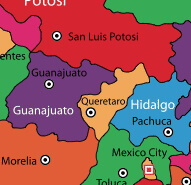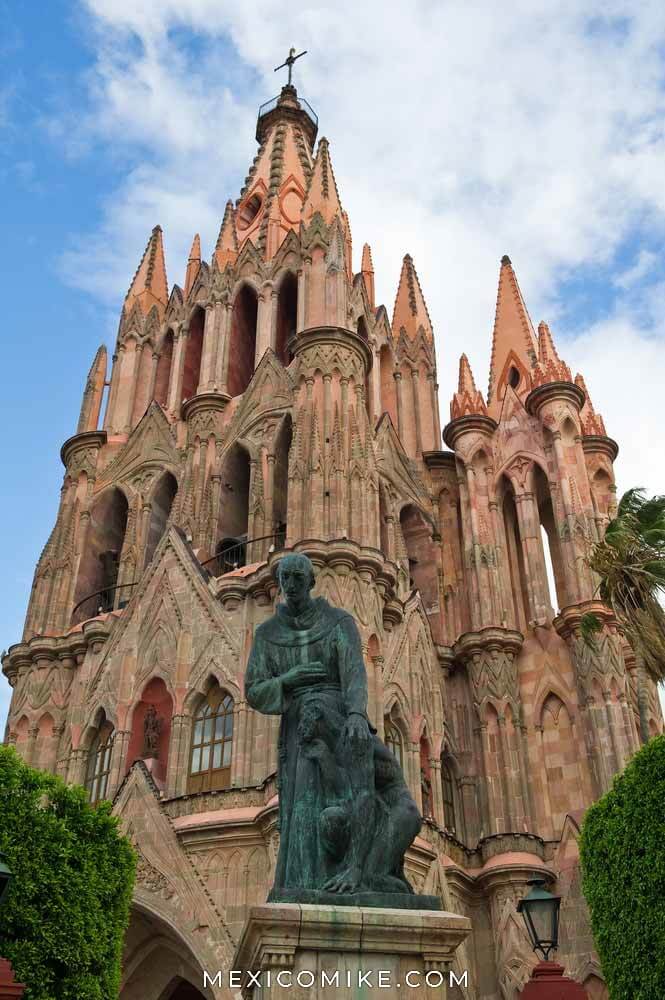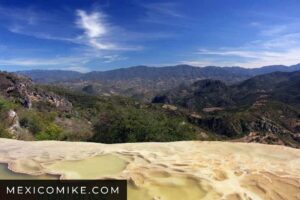
This north-central state of Mexico is one of the country’s smallest. Queretaro is bordered by the Mexican states of Michoacán, San Luis Potosi, Mexico, Guanajuato, and Hidalgo. In spite of its small size, Queretaro is largely known for its diverse terrain that ranges from desert to rainforest. With its capital city, also called Queretaro, the state attracts visitors from around the country and the world with its historical and cultural sites.
Important Facts
With an area of 4,511 square miles, Queretaro also celebrates a population 1,879,047 people. Its capital is also its largest city with a population of 804,663 people. This city is also a hub for culture and education for the state. Queretaro was admitted as a state in 1823 and is currently divided into eighteen municipalities. Besides the capital, other major cities in Queretaro include San Juan del Rio, Corregidora, and El Marques. Mining, especially for opals, is an important industry for the state; manufacturing, farming, and ranching are also essential features of the state’s economy.

Geography and Landscape
Mountains and mesas characterize much of Queretaro’s landscape. Situated in the western central region of Queretaro, the Mesa del Centro is an area of many small mesas. The northeast part of the state is home to mountains of the Sierra Madre Oriental while Trans-Mexican Volcanic Belt stretches across the southern and central area of Queretaro. Its borderland canyons and various snowcapped peaks provide this state with its distinctive terrain. Some of the state’s important rivers include the Moctezuma, El Pueblito, Jalpan, and San Juan. The state’s forests are notable for their stands of pine and oak forests. Animals such as deer, puma, woodpecker, rattlesnake, hare, porcupine, bobcat, and parrot make their home in Queretaro.

History
Although archaeologists continue to try to piece together the prehistoric past of many regions of Mexico, most assert that the earliest people to make their home in the Queretaro area were the Otomi. Agricultural practices, pottery, and weaving were hallmarks of their civilization which stretched throughout central Mexico. Over time, the Tarascan and Chichimeca would also control the Queretaro region. During the thirteenth century, the region was conquered by the Aztec people. Soon after the Spanish arrived in Mexico and began to conquer various territories, the Otomi people of Queretaro chose to form an alliance with the Spanish to overthrow the Aztecs. This alliance allowed one of the Otomi leaders to found the city of Queretaro. During the Colonial Period, the state and capital, in particular, sustained a strong economy and the territory developed into an important hub for trade as well as a center of culture. During the Mexican War for Independence, Queretaro remained under control of royalists until nearly the very end of the war. The city of Queretaro was also the site of the signing of the Treaty of Guadalupe Hidalgo at the end of the Mexican Revolution. During the French occupation, Queretaro was one of only four states to pledge allegiance to Emperor Maximilian, although he was later executed in 1867. Today, the capital receives many visitors as its historic center was named a UNESCO World Heritage Site in 1997.
Cuisine
The evolution of Queretaro’s gastronomy was influenced by many cultures—indigenous peoples, the Spanish, and even the French. Gorditas, stuffed tortillas, and enchiladas are specially prepared the Queretaro way. Other popular dishes include a ground beef and chili pepper specialty known as pacholas and a stuffed cactus favorite called nopal en penca which is typically made with prickly pear, chili, tomatoes, and onions. Sugared tamales and fried and cinnamon-coated sweets are some popular desserts in Queretaro. Of course, the capital offers a myriad of other types of cuisine like Italian, American, and Chinese.

Santiago de Queretaro
The capital is a must-see state attraction. Its historic center still features the geometric street plan designed by the Conquistadors but also includes the twisting avenues and alleys of the Otomi. Colonial architecture and Baroque monuments are just a few reasons National Geographic Magazine named the city one of the “top 15 historic destinations in the world.” Travelers will find many options when it comes to restaurants, nightlife, hotels, and inns. Tourists should certainly plan to see the City Aqueduct, Church of San Francisco, Church and ex-monastery of San Felipe Neri, Church and ex-convent of Santa Rosa de Viterbo, Theatre of the Republic, and Regional Museum.
Other Things to See and Do in Queretaro
Sierra Gorda Biosphere Reserve: Renowned for its diversity, this region is regarded as the natural jewel of the state. Its tropical forests and traditional cultures draw visitors from around the globe.
Museo de Arte: Situated in one of the country’s best-known Baroque buildings, this museum boasts one of the most important collections of colonial-era art.
Jalpan de Serra: With its historic Franciscan missions, this municipality is an important center of tourism for the state. In addition to the historic architecture, traditional handicrafts are popular among tourists.
El Cerrito: This ancient pyramid is one of the state’s most popular archaeological sites. The site dates from 600 A.D. and continues to be excavated and studied by archeologists and historians.
Tequisquiapan: This small town is billed as a popular weekend getaway. Located in the southeastern section of the state, Tequisquiapan is famous for its bougainvillea-filled streets, gardens, and picturesque pools.
Haciendas Tour: There are various tours of state attractions, but tours that feature Queretaro’s haciendas are favorites among travelers, particularly those that showcase these old plantations with cheese and wine tastings.
Ranas: This archeological site may be small, but it draws many visitors with its ball courts and pyramid.
Bernal’s Monolith: Known locally as the Pena de Bernal, this monolith is the world’s third-largest. A favorite hiking destination, the monolith is asserted to date back to the Jurassic Period. A small chapel is also situated halfway up the monolith.

San Miguel de Allende: This quaint and historic town is a lovely state attraction with its cobblestoned streets and historic architecture. Must-see sites of town include the Parish San Miguel, Angelo Peralta Theatre, and Allende’s House Museum.

San Miguel De Allende St Michael Cathedral

